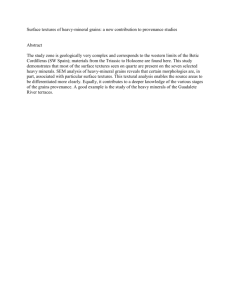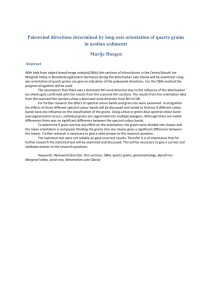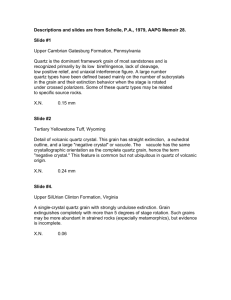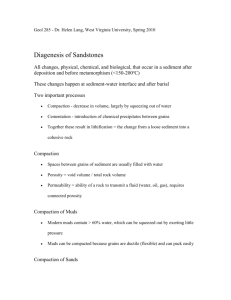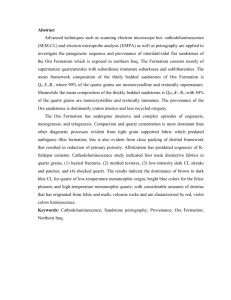Labs7/8 - Sedimentary Thin Sections Key
advertisement
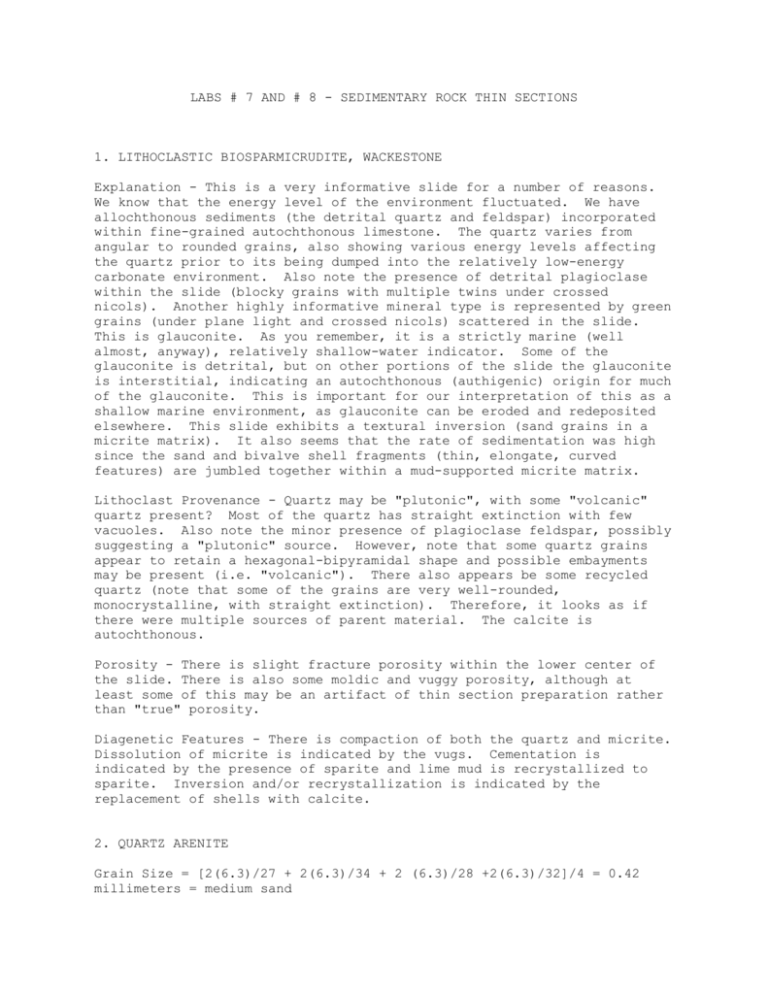
LABS # 7 AND # 8 - SEDIMENTARY ROCK THIN SECTIONS 1. LITHOCLASTIC BIOSPARMICRUDITE, WACKESTONE Explanation - This is a very informative slide for a number of reasons. We know that the energy level of the environment fluctuated. We have allochthonous sediments (the detrital quartz and feldspar) incorporated within fine-grained autochthonous limestone. The quartz varies from angular to rounded grains, also showing various energy levels affecting the quartz prior to its being dumped into the relatively low-energy carbonate environment. Also note the presence of detrital plagioclase within the slide (blocky grains with multiple twins under crossed nicols). Another highly informative mineral type is represented by green grains (under plane light and crossed nicols) scattered in the slide. This is glauconite. As you remember, it is a strictly marine (well almost, anyway), relatively shallow-water indicator. Some of the glauconite is detrital, but on other portions of the slide the glauconite is interstitial, indicating an autochthonous (authigenic) origin for much of the glauconite. This is important for our interpretation of this as a shallow marine environment, as glauconite can be eroded and redeposited elsewhere. This slide exhibits a textural inversion (sand grains in a micrite matrix). It also seems that the rate of sedimentation was high since the sand and bivalve shell fragments (thin, elongate, curved features) are jumbled together within a mud-supported micrite matrix. Lithoclast Provenance - Quartz may be "plutonic", with some "volcanic" quartz present? Most of the quartz has straight extinction with few vacuoles. Also note the minor presence of plagioclase feldspar, possibly suggesting a "plutonic" source. However, note that some quartz grains appear to retain a hexagonal-bipyramidal shape and possible embayments may be present (i.e. "volcanic"). There also appears be some recycled quartz (note that some of the grains are very well-rounded, monocrystalline, with straight extinction). Therefore, it looks as if there were multiple sources of parent material. The calcite is autochthonous. Porosity - There is slight fracture porosity within the lower center of the slide. There is also some moldic and vuggy porosity, although at least some of this may be an artifact of thin section preparation rather than "true" porosity. Diagenetic Features - There is compaction of both the quartz and micrite. Dissolution of micrite is indicated by the vugs. Cementation is indicated by the presence of sparite and lime mud is recrystallized to sparite. Inversion and/or recrystallization is indicated by the replacement of shells with calcite. 2. QUARTZ ARENITE Grain Size = [2(6.3)/27 + 2(6.3)/34 + 2 (6.3)/28 +2(6.3)/32]/4 = 0.42 millimeters = medium sand Sorting = moderate; High sphericity; Subangular to Rounded; chemically and physically mature Explanation - This is a very clean quartz sandstone which exhibits prominent grain suturing due to pressure solution. Note that many of the more sutured grains also have a sheared appearance. The sheared nature may be less a function of provenance than due to deep burial and other diagenetic processes. Although the quartz arenite contains very little clay it exhibits only moderate sorting with quite a range of quartz sizes in the specimen, with small grains between larger ones. However, before speculating about depositional energies check out the slide closely. Some polygranular quartz seems to have recrystallized to more stable, smaller grains. Therefore, sorting in this case may be as much (or more) a function of diagenetic processes (i.e. pressure solution and recrystallization) as to depositional environment. Provenance - There are many quartz grains that appear to be "stretched metamorphic". However, these may be due to diagenesis rather than provenance (a typical problem; see explanation below). The quartz has strong undulose extinction. Some internal "borders" of individual grains are crenulated. Some vacuoles and microlites are present. Porosity - There is a little intergranular porosity, but most porosity was destroyed through compaction and pressure solution. Diagenesis - There is tremendous compaction of quartz, dissolution of quartz due to compaction and pressure solution, and suturing of quartz grains. Quartz cement is precipitated between the grains and there are quartz overgrowths. Note how diagenesis masks the roundness and other textural characters of the grains. 3. BIOOOMICSPARRUDITE, GRAINSTONE (PACKSTONE O.K.) Explanation - This slide is a limestone in which sparite is dominant with some micrite found between a few of the grains. The sparite can be readily distinguished from the micrite under crossed nicols by its crystalline character. The round grains in the slide are oolites. Note the radial nature of these grains. This is probably due to polymorphic inversion from aragonite to calcite. The elongate grains are shell fragments, especially prominent are fragments of ribbed bivalves. These grains were deposited in a relatively high energy environment (probably a carbonate beach or shoal). Also characteristic of a shallow marine environment is the micritization apparent in this slide. The skeletal fragments are surrounded by micrite envelopes, formed by the disintegration of the skeletal material through chemical alteration by boring blue-green algae (cyanobacteria). In fact, several small mollusc fragments in the lower left hand corner of the slide exhibit very small bore holes along the margins of the shells produced by these endolithic algae. Provenance - Limestone is autochthonous. Porosity - There is minor intergranular porosity apparent (however, most pores were filled with sparite so porosity is low). Diagenetic Features - There is compaction of the fossils and oolites. Sparite is precipitated (i.e. cementation) and with possible recrystallization present. Under higher magnification, note that both drusy (needle-like) and blocky cement types are present, indicating two generations of cementation processes. There is polymorphic inversion of aragonite oolites to calcite (note the "starburst" pattern of the oolites characteristic of this process). There is replacement of shells with calcite. Boring of shells by organisms have formed "micrite envelopes"; i.e. dark "haloes" of micrite surrounding the grains. 4. FELDSPATHIC WACKE/GRAYWACKE Grain Size = [2(6.3)/28 + 2(6.3)/29 + 2(6.3)/31 + 2(6.3)/33]/4 = 0.42 millimeters = medium sand Sorting = poor; Sphericity = low; Roundness = angular to subangular; Physically and chemically immature Explanation - Under plane light, note the dingy clay minerals between the grains. There is also some diagenetic chlorites present, characterized by their green color and fine-grained nature. Most of the grains consist of quartz. These grains are clear under plane light and grey, greyishblue and straw-yellow under crossed-nicols. Many of the quartz grains exhibit strong undulatory extinction. There is also abundant plagioclase and potassium feldspars. The plagioclase is clear to slightly dingy under plane light, and is primarily bluish-grey under crossed nicols and exhibits the distinctive plagioclase twinning. There is also quite a bit of potassium feldspar scatttered throughout the slide. An especially large grain of potassium feldspar is in the upper right quadrant of the slide. This grain exhibits the characters seen in smaller feldspars in the slide, with blocky cleavage, a slightly dingy appearance under plane light due to diagenetic alteration, and gray coloration under crossnicols. There are also a few flecks of biotite. These are brown to green under plane light and are slightly pleochroic. Under crossed nicols, the biotites exhibit parallel extinction with slight development of "birdseyes", small circular areas within the biotite grains that do not go extinct with the rest of the crystal. Provenance - There are a couple of grains of microcline in this specimen (notice the gridiron twinning). This would suggest, in part at least, a probable sialic igneous (i. e. granite) provenance. There is also some biotite in the specimen, suggesting either plutonic igneous or schistose metamorphic provenance. However, there is also indication of more than one provenance for this specimen. Notice that there are both grains with straight extinction, and others that show strong undulatory extinction. The grains with straight extinction often show tiny inclusions and microlites, possibly indicating plutonic igneous origin. The strongly undulose grains may be a product of provenance rather than diagenesis (otherwise, wouldn't all grains exhibit strong undulose extinction as a result of terminal diagenetic events?) Porosity - The porosity is relatively low in this specimen. It has poor sorting, with the pores filled with matrix. However, many grains on this thin section exhibited "original" fracture porosity, although this appears to have been largely lost through cementation processes. Diagenesis - The most obvious diagenetic features of this rock involve the geochemical alteration of the grains by pore fluids. Notice how vacuolization has taken place within many of the feldspar grains, by which water percolated along cleavage planes and fractures, producing voids within the grains. Also, under plane light notice how dingy the feldspars appear. Diagenetic alteration, in the presence of water, has altered the feldspars to clays (this is often termed kaolinization, montmorillonitization, or illitization depending upon the clay product). Also, notice how a number of the clays have been altered to chlorite, another obvious diagenetic feature of this rock. Although there are numerous quartz grains exhibiting strong undulatory extinction in this slide, this may be due to provenance rather than diagenetic process (see discussion above). 5. SILTSTONE Explanation - Most of the grains within this slide are quartz as indicated by the blue-grey color and undulatory extinction. The silt is set within a clay matrix which tends to show up as grey-green blobs on the slide under plane light, and possess either grey or orange, yellow, purple and blue interference colors under crossed nicols (characteristic of the illite and smectite clays). Also, there are a number of plagioclase grains on the slide as characterized by their multipletwinned crystals. In this sense, this siltstone is neither texturally nor compositionally mature. Provenance - "Common" or "Plutonic" quartz appears to be present. Under higher magnification, note the "straight extinction" with few vacuoles present. The blocky, unaltered feldspars may also indicate a "plutonic" source. Porosity - There is some development of intergranular and fracture porosity on the specimen. Diagenetic Features - There is compaction and minor cementation of both the quartz and feldspars. However, some apparent "interparticle porosity" here may actually be due to plucking grains during thin section preparation. 6. DOLOMITE/ DOLOSTONE Explanation - One-half of several of these slides have been stained with a combination of Alizarin Red S (which causes calcite to stain red) and Potassium Ferricyanide (which causes ferrous iron to appear blue). This slide is largely unstained, although the slight bluish-purple tinge probably indicates a very slight iron content. The dolomite forms an interlocking mosaic of crystals. It's a good thing that this one was stained. Anhedral interlocking crystals of dolomite are practically indistinguishable from similar-shaped crystals of sparry calcite. Of course, Alizarin Red S will always do the trick for differentiating dolomite from calcite. This dolomite appears to have been pretty brittle and competent stuff since there appears to be quite a few fractures in it. However, you have to watch thin section structures because sometimes "fractures" and "moldic or vuggy porosity" can actually be produced during cutting and grinding the thin section! Provenance - Dolomite probably formed by polymorphic inversion of calcite (see below). Porosity - There is some fracture porosity present, and slight intercrystalline porosity developed between the dolomite crystals. Diagenetic Features - This sample probably represents polymorphic inversion of calcite to dolomite (a process termed dolomitization). Note the "crystals" and "intercrystalline material" under plane light. There is probable dissolution and recrystallization of dolomite "cement" between the "grains" of dolomite. Compaction is indicated by the many fractures present on the slide. 7. FELDSPATHIC WACKE (LITHIC WACKE O.K.) Grain Size = [2(6.3)/21 + 2(6.3)/16 + 2(6.3)/16 + 2(6.3)/17]/4 = 0.73 millimeters = coarse sand Sorting = poor to moderate; Sphericity = low; Roundness = subangular to angular; Chemically and physically immature Explanation - In many ways, this slide is similar to specimen # 4. Under plane light, note the dingy clay minerals between the grains. There is also some diagenetic chlorites present, characterized by their green color and fine-grained nature. Most of the grains consist of quartz. These grains are clear under plane light and grey, greyish-blue and straw-yellow under crossed-nicols. Many of the quartz grains exhibit strong undulatory extinction. There is abundant plagioclase and potassium feldspars as in # 4, but there is also microcline present in specimen # 7. The plagioclase is clear to slightly dingy under plane light, and is primarily bluish-grey under crossed nicols and exhibits the distinctive plagioclase twinning. The potassium feldspars exhibit blocky cleavage, a slightly dingy appearance under plane light, and gray coloration under cross-nicols. The microcline is characterized by the distinctive "gridiron twinning", by which the crystals exhibit a "checkerboard" pattern under crossed-nicols. There is much more biotite in this specimen versus that seen in # 4. These are brown to green under plane light and are slightly pleochroic. Under crossed nicols, the biotites exhibit parallel extinction with good development of "birdseyes", small circular areas within the biotite grains that do not go extinct with the rest of the crystal. Although I will accept the name "lithic wacke" for this specimen, total feldspar content is greater that that of biotite "lithics". Therefore, the proper name of this specimen should be feldspathic wacke. Provenance - Although specimens # 4 and # 7 are quite similar in appearance, there may be some differences in provenance. Although many quartz grains in # 4 show straight extinction, virtually every quartz grain in # 7 exhibits strong undulose extinction. Also, there is abundant mica in this specimen, several of which still exhibit multilayered "book-like" structures. These may represent small pieces of schist, suggesting a schistose metamorphic provenance. However, there is also some microcline present in this sample, which is likely of plutonic igneous (i.e., granite) provenance. Therefore, multiple sources of parent material may be indicated. Porosity - There is some intergranular (interparticle) porosity between the sand, and some fracture porosity (see upper left of slide). Diagenesis - As in specimen # 4, the most obvious diagenetic features of this rock involve the geochemical alteration of the grains by pore fluids. Dingy feldspars and alteration of feldspars to chlorite and other clays indicate that considerable water-rich diagenetic processes influenced this specimen. Also, at least some (and maybe a lot) of the undulose extinction of the grains may be due to diagenesis, as it is apparent that this specimen was really "crunched" after deposition. Therefore, it is difficult to differentiate features of this specimen due to provenance versus those created during diagenesis. 8. POLYMICTIC EXTRAFORMATIONAL PARACONGLOMERATE Explanation - Hold the slide up to the light before placing it on the microscope stage. Note the presence of several pebbles indicating the conglomeratic nature of this specimen. I called this a paraconglomerate as the pebbles are not touching. The numerous quartz grains and lack of matrix (at least clay matrix) caused me to ponder an orthoconglomerate classification rather than a paraconglomerate. Also, as a thin section is a two-dimensional surface it is possible that on the original rocks some clasts were touching (remember that discussion?). A major purpose in classifying rocks is to define transport energies and depositional environments. The presence of numerous quartz grains in contact with one another and the sparcity of clay matrix in this specimen indicates a considerable amount of current activity (also note that the sand and gravel is well-rounded). Despite this, I called this specimen a paraconglomerate as the pebbles do not touch. I also called the congomerate polymictic and extraformational since the pebbles are made of polygranular quartz and the quartz sand is almost certainly of different provenance. Provenance - There are some reworked sedimentary chert clasts (i.e., recycled sedimentary provenance). Most of the quartz appears to be "common" or "plutonic". The "common/plutonic" quartz has straight extinction, with some vacuoles present and a few microlites. There also seems to be a number of probably recycled sedimentary sand-sized quartz grains (note that some of the grains are very well-rounded, monocrystalline, and with straight extinction). Porosity - There is not much development of porosity here. Some of the quartz grains exhibit slight intergranular porosity between them. Diagenetic Features - The quartz grains indicate some compaction and dissolution. Note the curved contacts between the grains due to pressure solution due to grain-to-grain contact and dissolution. Cementation is by silica. There is also authigenesis and/or cementation by hematite as indicated by the brown stains under plane light. 9. MUDSTONE/ SHALE/ ORTHOCLAYSTONE Explanation - This slide is composed almost entirely of clay minerals (pretty dingy and nondescript stuff, huh?), although quite a few very small quartz grains may be distinguished under higher magnification. There are some small fractures within the clays. The quartz silt-filled, rounded structures (see center and upper left edge of slide) are most likely cross-sections of silt-filled burrows. Other burrows may be present along the left edge of the slide, showing up as elongate or oval stained features. A slight suggestion of fine silt laminae are present in the lower portion of the slide. Provenance - Impossible to determine optically. Porosity - There is not much porosity, as the fractures were later infilled with silica cement. Diagenetic Features - The clay is compacted. It is fractured with precipitation (dissolution, cementation) of quartz within the fractures. Bioturbation may be indicated by the possible presence of burrows. 10. LITHOCLAST-BEARING DOLOMITIC PELMICRITE, PACKSTONE (WACKESTONE O.K.) Explanation - Some portions of this slide have been dolomitized. The dolomite is unstained and under crossed nicols exhibits either gray or pretty yellow, orange, pink and green interference colors. However, some of the rounded- to oval dark micritic areas of the slide are partially infilled with quartz silt. These probably represent burrow fillings. Other quartz silt (clear under plane light, blue-grey with undulatory extinction under crossed nicols) can be seen within clasts of limestone. The small ovoid micritic grains I interpret as pellets (or peloids). Other larger clasts I interpret mostly as intraclasts. There may be a single, sparite-filled cross-section of a small bivalve shell in the lower center of the slide. Although much of the material between the grains is lime mud (micrite), there is also considerable microcrystalline sparite and dolomite present. Provenance - The limestone is autochthonous. The few quartz grains present appear to be "plutonic" or "common". This is indicated by the straight to slightly undulose extinction of the quartz, with few vacuoles present. Porosity - There is not much porosity here; there may be some intercrystalline between the dolomite crystals. Diagenetic Features - There was compaction of the pellets. Some microstylolites are present in the lower left of the slide (notice around the edges of a couple of the intraclasts). There is slight dissolution of the micrite and cementation by sparite. There is considerable replacement of calcite by dolomite (unstained parts) and "cementation" by interstitial dolomite. Bioturbation is indicated by the minor presence of burrows and the presence of numerous pellets left by burrowing detritus-feeding animals. 11. ORGANIC LITHOCLASTIC PELSPARMICRITE, WACKESTONE (PACKSTONE O.K.) Explanation - This specimen is as allochthonous as it is autochthonous. Between the red-stained calcite portions of the slide there are numerous quartz silt grains, as well as dark organic-rich clays. However, much of the material seems to have been deposited within the fractured limestone, as much of the limestone on opposite sides of the clay-filled fractures match up. Therefore, there were at least two depositional events; the first deposited lime mud, the second organic shale and silt. These events were separated by a diagenetic event in which the limestone was fractured (and possibly partially dissolved) prior to the deposition of the clay and silt. As concerns the limestone, the micritic nature of the limestone is readily apparent and the only allochem type abundantly present seems to be pellets/peloids. There also seems to be some minor recrystallization to sparite within the lower left portion of the slide. Provenance - The limestone is autochthonous. The quartz appears to be "common" or "plutonic". This is indicated by straight extinction and the presence of a few vacuoles. A couple of tiny grains of microcline are present (see gridiron twinning), also suggesting a plutonic source. Porosity abundant There is replaced - There is not much porosity apparent. There were initially fractures, but these have been infilled by organics and clays. slight intercrystalline porosity developed where the dolomite the calcite crystals. Diagenetic Features - There was compaction of the pellets. Dissolution and cementation by sparite is indicated, and there are microstylolites apparent on the specimen. Calcite was recrystallized to dolomite, as indicated by the unstained portions of the slide which are surrounded by red-stained calcite. These unstained areas exhibit calcite-like interference colors. There was considerable bioturbation with mixing of organic and micrite muds and also indicated by the presence of pellets of detritus-feeders. 12. PELBIOMICSPARRUDITE, PACKSTONE (GRAINSTONE O.K.) Explanation - This specimen was stained with Alizarin Red S and Potassium Ferracyanide. The presence of a red tint, coupled with purple stain, indicates the presence of calcite and iron. Although not abundant, the dingy tint of the intercrystalline material indicates that some micrite is present. The abundance of grain-supported fossils and the slight mud content (but less than 10%) led me to call this a packstone. A wide variety of fossils may be seen in this slide including small club-like bryozoans (see lower right side of slide) and numerous cross-sections of bivalve shells. The other fan-shaped, porous structures may also represent bryozoans, although some calcareous algae also has this appearance. Pellets/peloids are represented by sand-sized grains of dark micrite. There are also dark, quartz silt-filled round- to oval burrows present and, along with the pellets, also indicate bioturbation by detritus feeders. Provenance - Limestone is autochthonous. Quartz silt appears to be "common" or "plutonic", with straight extinction and minor vacuoles present. Porosity - There is not much porosity. Formerly there were tiny fractures, but these have been infilled with sparite. Diagenetic Features - There is abundant evidence of compaction/pressure solution here, with fracturing and microstylolites present. There is cementation by sparite with recrystallization of lime mud to this coarsely crystalline sparite. Dissolution is indicated by the presence of microstylolites, well illustrated on the left edge of the slide as brown, hematite-stained areas of organics and silt. Bioturbation is indicated by the presence of silt-filled burrows, especially seen along the left lower edge of the slide. 13. ANHYDRITE Explanation - The anhydrite crystals in this slide range from elongate shreds to roughly tabular shapes due to the nature of anhydrite cleavage. Under crossed nicols, it produces colorful interference colors and it "twinkles" as the stage is rotated under crossed nicols (watch out since calcite also "twinkles" when you rotate the stage as you have probably noticed in other slides). However, calcite would never have the "shredded" appearance of these anhydrite crystals. Provenance - Probably autochthonous, although anhydrite is often formed through dehydration of gypsum (in which case it would be diagenetic). Porosity - There is some intercrystalline and fracture porosity, although this may be an artifact of the thin section grinding process rather than "true" porosity. Diagenesis - Some compaction is probably indicated by the orientation of the anhydrite crystals. Some pressure solution and dissolution is indicated at the boundaries of the grains. 14. CHERT Explanation - Note the slight brownish color of this specimen under plane light. Although many cherts are nearly colorless under plane light, it is not uncommon for specimens to exhibit various shades of brown or reddish-brown due to the presence of iron-bearing minerals. In crossednicols, notice the microcrystallinity of the specimen and its black-gray speckled appearance. This is diagnostic of chert. As chert is basically amorphous, it should be nearly isotropic in crossed-nicols (as seen in this specimen). This specimen was fractured at some time during its diagenetic history, after which microcrystalline quartz was precipitated within the fractures. Notice that the quartz crystals within the fractures are slightly larger than those of the chert. Provenance - Although there is no reason to fact, some structures fossils, suggesting a we cannot be certain (without more detailed study), debate an autochthonous origin for this chert. In may represent cross-sections of relatively large biogenic origin for this rock. Porosity - Fracture porosity was originally developed in this specimen. This provided a conduit for dissolution to take place, and resulted in the development of larger vugs along the fractures. However, there is essentially no porosity currently seen in this specimen, as the fractures were later filled with quartz precipitates. Diagenesis - Fracturing and dissolution (as indicated by infilled vugs) are apparent in the specimen. Within these fractures and voids, secondary microcrystalline quartz has been precipitated from pore fluids. 15. GLAUCONITIC SANDSTONE Grain Size = [2(6.3)/28 + 2(6.3)/34 + 2(6.3)/38 + 2(6.3)/30]/4 = 0.39 millimeters = medium sand Sorting = moderate; Sphericity = moderate to high; Roundness = subangular to rounded; Chemically mature and physically immature Explanation - The lab worker who made this slide had some real problems. Glauconite is a very soft clay-like mineral, so when a thin section is ground the glauconite grains tend to be plucked out rather than ground down. Look at the slide under plane light. Note the round "ghost crystals" where the glauconite has been plucked out. Also notice that in these voids there are black "crosses", which appear to rotate under crossed-nicols when the stage is rotated. These weird isotropic areas were created due to the holes in the specimen during slide processing. Of course, these thin section preparation problems will influence your textural interpretations, such as grain size, sorting, and "true" porosity. The glauconite in this slide is green to greenish-brown under plane light and crossed nicols. The other grains in the slide are quartz. These are clear under plane light and gray to straw-yellow under crossed nicols. Although many minerals may be associated with glauconite, quartz seems to be especially common within the shallow marine environments where glauconite forms. Provenance - The quartz in this slide is allochthonous, whereas the glauconite is an early diagenetic mineral. The slide preparer had such a tough time with this specimen that I hesitate to suggest a provenance for the quartz. The embayments and shattered appearance of the grains may actually be a relict of the thin section-making process rather than a reflection of provenance. However, many of the quartz grains show strong undulose extinction, so we can probably rule out an igneous plutonic provenance. However, glauconites are (usually) very specific in terms of provenance / depositional environments. They indicate marine, normal salinity, weakly-reducing conditions with slow rates of deposition and 50 to 1,000 meters water depth. Porosity - Most of the "intergranular porosity" in this specimen is probably due to thin section production, where the glauconites were plucked out during the grinding process. Many of the quartz grains have abundant fractures in them, but this may be due to the fact that the lab technician shattered the quartz grains trying to get the glauconites thin enough to see some structures in them. Diagenesis - Again, the plucking and shattering of grains by the lab technician makes interpretation of diagenesis tougher. However, glauconite is a diagenetic mineral that usually forms in the presence of organic matter at or near the sediment-water interface in marine environments. Reworking of sediments by organisms, another early diagenetic process, is suggested by the presence of at least one grapestone-like structure incorporating several glauconite grains, probably indicating the ingestion of the mud by detritus-feeding animals. 16. OIL SHALE/KEROGEN SHALE Explanation - Hold this slide up to the light before placing it under the microscope. Notice the coloration, fine-grained nature, and lamination that characterize this specimen. Under plane light and crossed-nicols, the medium to dark-brown material consists of clay minerals. Notice the tiny quartz grains imbedded within the clays, especially apparent under higher magnification. The opaque black material in this slide is kerogen, a hydrocarbon type that consists largely of disintegrated plant debris. The kerogen material in this slide appears to be vitrinite, so we could possibly get some information concerning paleothermometry if we had a scope with reflectance-measuring capabilities (maybe we will buy an instrument for the next seds class, huh? - oh boy, would they have fun!). There are some slightly larger crystals of material associated with the kerogen that are clear under plane light. Under higher magnification and under crossed-nicols they yield low-order interference colors. As these are relatively small crystals it is difficult to determine their precise composition. However, it is probable that they represent one or more varieties of evaporite minerals, which are commonly associated with oil shale. Provenance - Kerogen shale is typical of lacustrine environments, and the fine laminations and abundant hydrocarbons and kerogen in this specimen would suggest such an origin for this specimen. Porosity - There is virtually no porosity in this specimen, although there are a few small fractures in the lower left of the slide. Diagenesis - Compaction of the shale would be an early diagenetic feature of this specimen. Imbedded within the dark organic layers, microcrystals of pyrite are scattered throughout the slide. Such crystals are often secondary precipitates within anaerobic sediments, as would probably be the case here. The precipitation of the tiny evaporite crystals may also, in part, be diagenetic.
